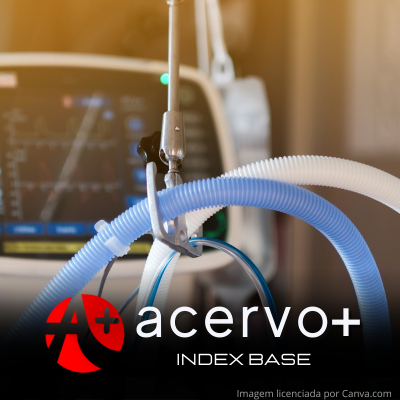Pneumonia associada à ventilação mecânica e seus fatores de riscos: um estudo observacional
##plugins.themes.bootstrap3.article.main##
Resumo
Objetivo: Verificar o perfil de pacientes internados em UTI adulto e os fatores de risco associados à ocorrência de PAV. Métodos: Trata-se de um estudo transversal, que foi realizado entre janeiro de 2018 e dezembro de 2020, cujos participantes eram indivíduos internados na UTI adulto de um hospital do ES. Resultados: Um total de 425 pessoas foram incluídos no estudo. A regressão logística binária multinominal mostrou que pacientes com tempo de VM entre 10 e 14 dias (OR = 6,94; p < 0,001; IC 95% = 1,99 – 24,42) e mais de 14 dias (OR = 7,15; p < 0,001; IC 95% = 2,78 – 20,94) eram mais propensos a PAV. Associações foram encontradas entre doença pulmonar obstrutiva crônica (OR = 2,75; p < 0,05; IC 95% = 0,64 – 9,87), diabetes mellitus tipo 2 (OR = 2,70; p < 0,001; IC 95% = 1,13 – 6,34), COVID-19 (OR = 2,07; p < 0,01; IC 95% = 0,75 – 5,38) e ocorrência de PAV. Conclusão: Pacientes com aumento do tempo de VM, com comorbidades e internados por infecção causada por COVID-19 têm alto risco de desenvolver PAV.
##plugins.themes.bootstrap3.article.details##
Copyright © | Todos os direitos reservados.
A revista detém os direitos autorais exclusivos de publicação deste artigo nos termos da lei 9610/98.
Reprodução parcial
É livre o uso de partes do texto, figuras e questionário do artigo, sendo obrigatória a citação dos autores e revista.
Reprodução total
É expressamente proibida, devendo ser autorizada pela revista.
Referências
2. AGÊNCIA NACIONAL DE VIGILÂNCIA SANITÁRIA (ANVISA). Nota técnica GVIMS/GGTES/ANVISA nº 02/2021: Critérios diagnósticos das infecções relacionadas à assistência à saúde. 2021; 35.
3. AMERICAN THORACIC SOCIETY (ATS). Guidelines for management of adults with hospital-acquired, ventilator-associated, and healthcare-associated pneumonia. J Res Crit Care Med, 2005; 171(4): 388-416.
4. ANDRIOLO BN, et al. Early versus late tracheostomy for critically ill patients. Cochrane Database Syst Rev, 2015; 1(1): CD007271.
5. BACCOLINI V, et al. The impact of the COVID-19 pandemic on healthcare-associated infections in intensive care unit patients: a retrospective cohort study. Antimicro Resist Infect Control, 2021; 10(1): 87.
6. CENTERS FOR DISEASE CONTROL AND PREVENTION (CDC). Pneumonia (ventilatorassociated [VAP] and non-ventilator-associated pneumonia [PNEU]) event. Atlanta: CDC, 2023; 19.
7. CRAVEN TH, et al. Ventilator-associated pneumonia surveillance using two methods. J Hosp Infect, 2020; 104(4): 522-528.
8. CUI JB, et al. Risk factors for early-onset ventilator-associated pneumonia in aneurysmal subarachnoid hemorrhage patients. Braz J Med Biol Res, 2020; 1353(1): e6830.
9. DANANCHÉ C, et al. Trends of incidence and risk factors of ventilator-associated pneumonia in elderly patients admitted to French icus between 2007 and 2014. Crit Care Med, 2018; 46(6): 869-77.
10. DILING WU, et al. Risk Factors of Ventilator-Associated Pneumonia in Critically III Patients. Front Pharmacol, 2019; 9(10): 482.
11. GRASSELLI G, et al. Hospital-acquired infections in critically Ill patients with COVID-19. Chest, 2021; 160(2): 454-65.
12. HASSOUN-KHEIR N, et al. Risk factors for ventilator-associated pneumonia following cardiac surgery: case-control study. J Hosp Infect., 2020; S0195-6701(20): 30184-5.
13. KÓZKA M, et al. Risk Factors of Pneumonia Associated with Mechanical Ventilation. Int J Environ Res Public Health, 2020; 17(2): 656.
14. LOPEZ-DE-ANDRES A, et al. Sex differences in hospital-acquired pneumonia among patients with type 2 Diabetes mellitus patients: retrospective cohort study using hospital discharge data in Spain (2016-2019). Int J Environ Res Public Health, 2021; 18(23): 12645.
15. MAES M, et al. Ventilator-associated pneumonia in critically ill patients with COVID-19. Crit Care, 2021; 25(1): 25.
16. NSEIR S, et al. Relationship between obesity and ventilator-associated pneumonia: a post hoc analysis of the NUTRIREA trial. Chest, 2021; 159(6): 2309-17.
17. NÚÑEZ SA, et al. Ventilator-associated pneumonia in patients on prolonged mechanical ventilation: description, risk factors for mortality, and performance of the SOFA score. J Bras Pneumol, 2021; 47(3): e20200569.
18. PAPAZIAN L, et al. Ventilator-associated pneumonia in adults: a narrative review. Intensive Care Med, 2020; 46(5): 888-906.
19. SHAH H, et al. Trends and Factors Associated With Ventilator-Associated Pneumonia: A National Perspective. Cureus, 2022; 14(3): e23634.
20. SOCIEDADE BRASILEIRA DE PNEUMOLOGIA E TISIOLOGIA (SBPT). Diretrizes brasileiras para o tratamento das pneumonias adquiridas no hospital e das associadas à ventilação mecânica. J Brasil Pneumol, 2007; 33(1): S1-S30.
21. WU D, et al. Risk Factors of Ventilator-Associated Pneumonia in Critically III Patients. Front, 2019; 10: 482.
22. YIN M and LIU M. Effect of chronic obstructive pulmonary disease combined with ventilator-associated pneumonia on patient outcomes: A systematic review and meta-analysis. Exp Ther Med, 2020; 20(6): 273.
23. ZHAO X, et al. Epidemiological and clinical characteristics of healthcare-associated infection in elderly patients in a large Chinese tertiary hospital: a 3-year surveillance study. BMC Infect Dis. 2020; 20(1): 121.
24. SHAH H, et al. Trends and Factors Associated With Ventilator-Associated Pneumonia: A National Perspective. Cureus, 2022; 14(3): e23634.

